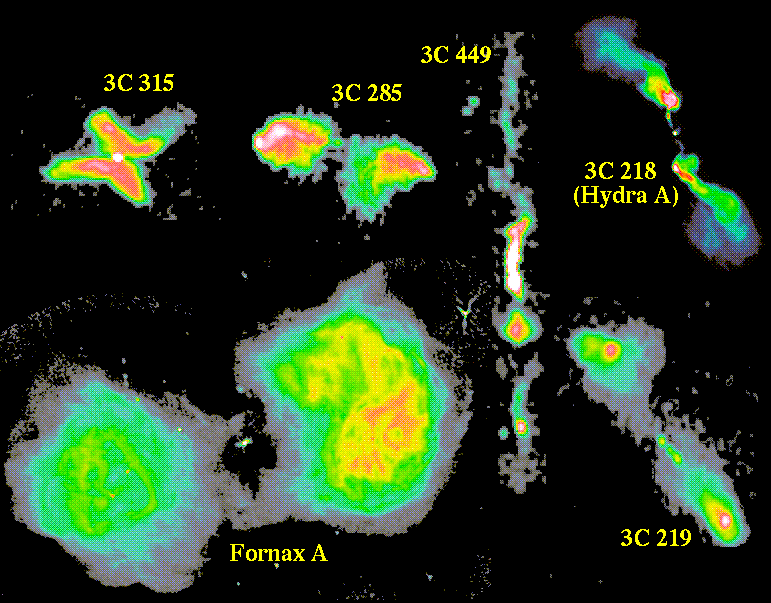
Radio galaxies are best known for their extensive double radio sources, shining by synchrotron radiation as electrons spiral through magnetic fields at relativistic speeds. These objects show a remarkable variety of forms and symmetries, as shown in this montage of radio images of radio galaxies. These are of so-called Fanaroff-Riley (FR) type I, with radio lobes decreasing smoothly in intensity outwards from the central source - for the contrasting case of an FR II source, see the Cygnus A slide. Ordinary, symmetric double structure is seen in Fornax A, 3C 219, and 3C 285. Hydra A (3C 218) exhibits an interesting corkscrew form, sometimes seen as suggesting a long-term precession of the jets feeding outwards from the nucleus, while 3C 449 shows a very long and extended set of helical twists more or less symmetric about the core. The radio source of 3C 315 is so tightly twisted that it takes on the shape nicknamed by Jacques Vallee and his Francophone collaborators as Papillon - the butterfly.
In each case, the optical galaxy spans only a small part of the range of the radio source. In Fornax A, it fills the gap between the two lobes, and in the other cases the visible galaxies are much smaller compared to the radio source extent.
Data for Fornax A, 3C 285, 3C 315, and 3C 219 were taken from the "Images from the Invisible Universe" CD-ROM distributed by NRAO. Of these, all but 3C 219 are VLA maps at 21 cm, while 3C 219 was mapped at 11 cm using the interferometer of the Mullard Radio Astronomy Observatory in the UK. The Fornax A data were presented by E. Fomalont, K. Ebneter, W. van Bregel, & R. Ekers in ApJL 346, L17 (1989), and the data for 3C 285, 219, and 315 are from a study by P. Alexander and J.P. Leahy in MNRAS 225, 1 (1987). The data for 3C 449 span a 0.15-degree field and are from the NRAO VLA Sky Survey (NVSS) via WWW retrieval. Leahy has pointed out that the extreme north and south extensions on 3C 449 are artifacts of the FIRST survey data collection. While I try to find all the data again to fix that in the display, I can recommend you peruse their DRAGNs collection of double radio source data.